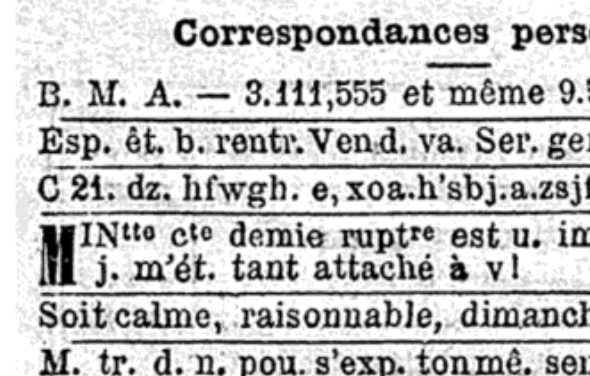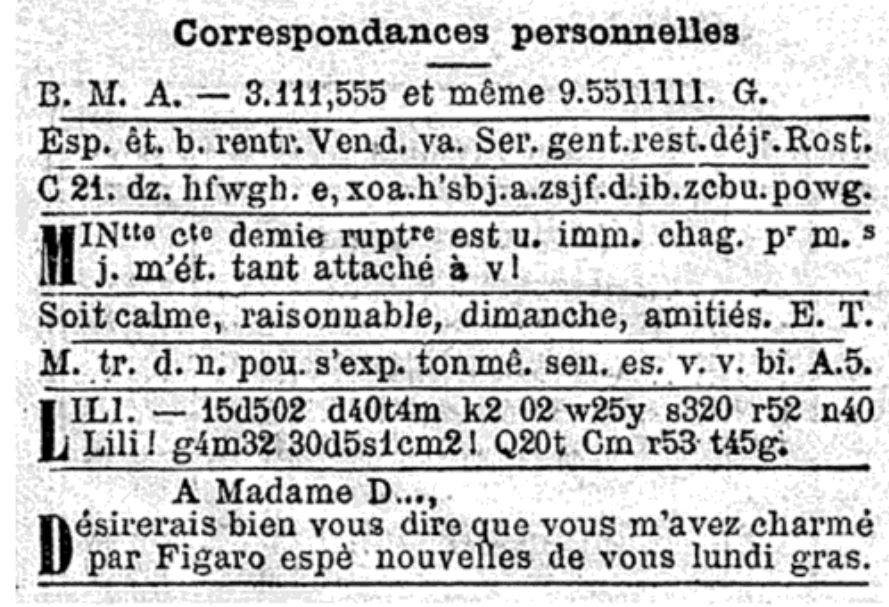Scrambled newspaper ads from France
My readers have brought to my attention scrambled newspaper ads from 19th century France. Two of them are still unsolved.
Once again I could rely on my readers – in this case even several times. A few weeks ago, I reported that in the literature on crypto history, there are some reports of encrypted newspaper advertisements that appeared in France in the 19th century. However, I had never seen one. Also, in the same article, I presented a previously unsolved encrypted advertisement from England.
Shortly thereafter, Jarl Van Eycke solved the English ad (and thus a cryptological cold case). I will discuss this great achievement in a separate article.
In addition, two readers drew my attention to encrypted ads from France, thus answering the actual question from my article. I will present some of these cryptograms, which Thomas Bosbach pointed out to me, in the following. Some other tips come from Didier Müller. There will be a separate blog article on these.
Advertisements in the Figaro
Thomas Bosbach discovered a chapter on encrypted newspaper ads in the French book “La Bible des codes secrets” (2019) by Hervé Lehning. They come from the daily newspaper “Le Figaro”. Four blocks of advertisements are illustrated in this work. The first block dates from January 1, 1890:
The first of the two ads is encoded with a Caesar cipher. “Cpoof booff” stands for “Bonne Année”.
The second cryptogram is also based on a Caesar cipher. When decrypting, the following applies: A->Z, B->A, C->B, etc. Exceptions are the vowels, which are encoded according to the scheme A=1, E=2, I=3, O=4, U=5. The following plaintext is obtained, which contains some abbreviations:
a v le premier mes veux bonn ann voud etre t pres d v n pens q rev
So this is also about New Year’s greetings.
The next advertisement in Lehning’s book dates from January 12, 1890:
Here again the combination of Caesar and vowel substitution with numerous abbreviations is used. The two este words are “Compl. retabl.”.
The following advertisement was published on January 23:
Here, too, the method used is very simple. It is a so-called atbash encryption, which follows the following scheme (V and W are not distinguished in this case): A->Z, B->Y, C->X, D->V, E->U, F->T, G->S, H->R, I->Q, J->P, K->O, L->N. The plaintext thus begins with “B7. tr. inq. Pai.recu …” and again contains many abbreviations.
Two unresolved ads
The following block, which Lehning presents in his book, contains two scrambled advertisements:
Es handelt sich um die dritte (C 21) und um die vorletzte (LILI) Anzeige. Die Lösungen sind im besagten Buch von Lehning nicht angegeben und werden stattdessen dem Leser überlassen. Schafft es ein Cipherbrain-Leser, die beiden Kryptogramme zu knacken?
If you want to add a comment, you need to add it to the German version here.
Follow @KlausSchmeh
Further reading: Verschlüsselte Zeitungsanzeigen, Teil 2: Eine mysteriöse Anzeigenserie
Linkedin: https://www.linkedin.com/groups/13501820
Facebook: https://www.facebook.com/groups/763282653806483/







Letzte Kommentare